
Traditional “Between Bearings Compressors” (belonging to Not-Integrally Geared category) are composed by an external casing containing up to 3 sections, each one with one or more compression stage (up to 10 in total). For each stage an impeller is mounted on the single rotating shaft and the whole rotating assembly is named rotor.
A section includes the set of consecutive stages that do not have inter-refrigeration or side stream injections/extractions of the processed fluid. Each section includes conveyor, inlet volute and several stages with impeller, diffuser and return channel, up to the last one including impeller, diffuser, outlet volute and outlet pipe. The rotating part of the compressor consists of the impeller(s) and the shaft. This rotor runs on two radial bearings (on all modern compressors, these are hydrodynamic tilt pad bearings). A balance piston is generally provided to reduce the axial thrust generated by the impellers. A hydrodynamic tilt pad thrust bearing is used to balance the residual axial thrust.
Some processes require compression trains with several (up to 4) casings. The casings can have different arrangement of the sections:
•Straight Through (suction of the following section adjacent to the discharge of the previous one) with side stream, if necessary
•Back-To-Back (adjacent sections discharge)
•Double Flow (two sections in back-to-back arrangement, working in parallel)

STRAIGHT-THROUGH
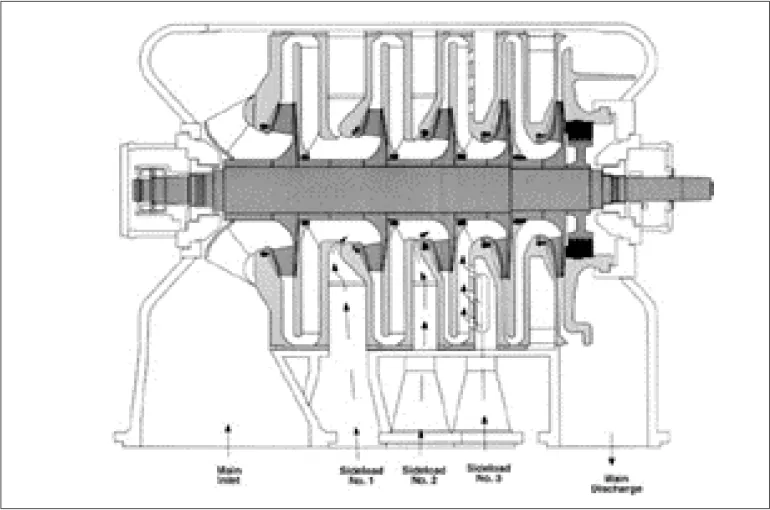
STRAIGHT-THROUGH WITH SIDE STREAMS
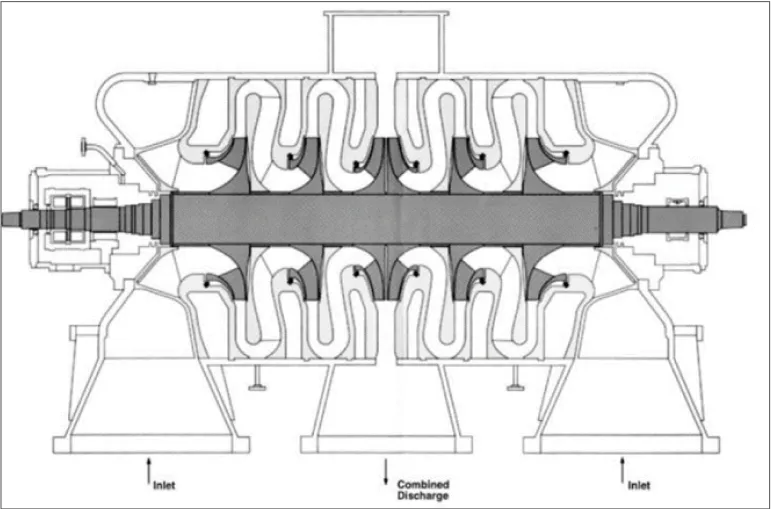
DOUBLE FLOW
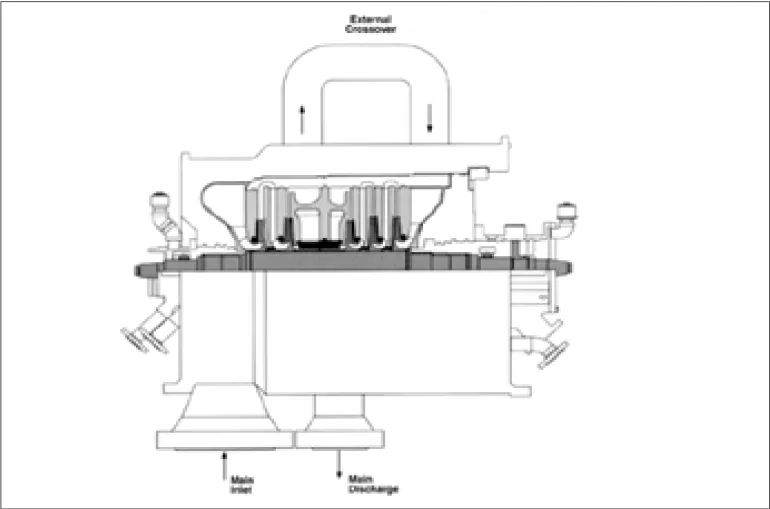
BACK-TO-BACK
•Horizontally Split Compressors
•Vertically Split Compressors
As it will be explained in the following paragraph, the choice of the external casing layout (with its advantages and disadvantages) remarkably affects maintenance operations.
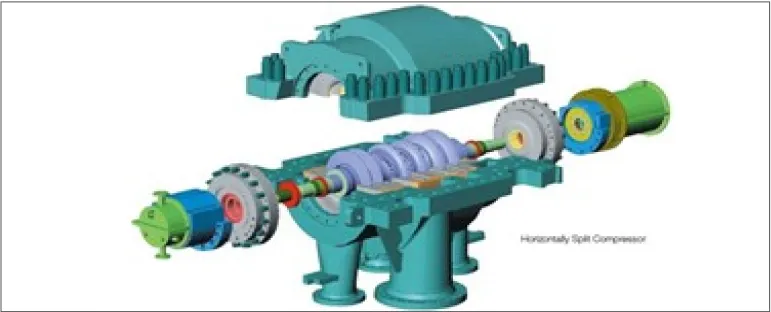
HORIZONTALLY SPLIT COMPRESSOR

VERTICALLY SPLIT COMPRESSOR
Maintenance of the horizontally split compressor is very simple, as, after removing the top half casing, the rotor can be removed without disassembling the impellers and then bearings and seals are readily accessible for inspection and repairs. Of course, unless the process connections are placed in the bottom half (as commonly it happens in case of condensing Steam turbine driving), they must be removed before opening the case. Horizontally split casings are usually applied for discharge pressure up to 40-60 bar.
When the pressure is higher, or the molecular weight is too low, vertically split (“barrel type”) compressors are used to avoid gas leakage from the two casing halves of horizontally split compressor. In this case the complete bundle (rotor and split diaphragms) must be removed for maintenance to access the rotor; adequate space is necessary for this operation (also removing of additional casing opposite driver side, if any) but no need to remove the inlet and outlet flanges.
Vertical split compressor used for high pressures, can also have bell shaped casing, with a single vertical end cover, closed with shear rings instead of bolts.
Special arrangements is used for Pipeline Compressors, used for natural gas transportation: normally they have side suction and delivery nozzles positioned opposite each other to facilitate installation on gas pipelines. Axial inlet is also available when the pressure ratio allows for a single impeller.
The maximum number of impellers (up to 10) in Between-Bearings compressor casings is usually limited by rotor-dynamic considerations. Therefore, the maximum amount of head to be generated in one casing is limited. If more head is required, multiple casings, driven either by the same driver or by separate drivers, must be used.
Integrally Geared Compressors are composed by one or more stages, each one including conveyor, impeller, diffuser, volute, and outlet pipe. They are usually inter-refrigerated, being frequently the intercoolers included as part of the machine package. The casing is also attached to the gear box, which is connected to the foundations, the bull gear is connected to the driver by means of a coupling.
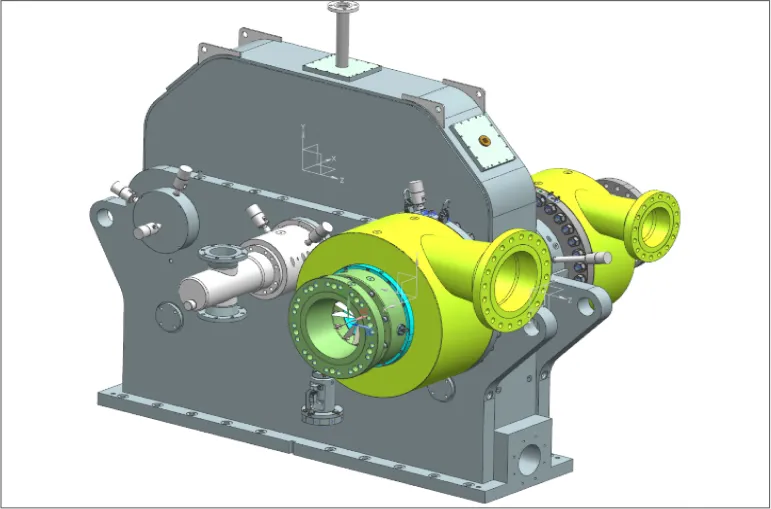
TYPICAL INTEGRALLY GEARED COMPRESSOR
Same compression stage arrangement is adopted also for single stage compressors with overhung impeller (even if they are Not-Integrally Geared).
Usually, overhung compressors do not permit the removal of the rotor without first removing the impeller.
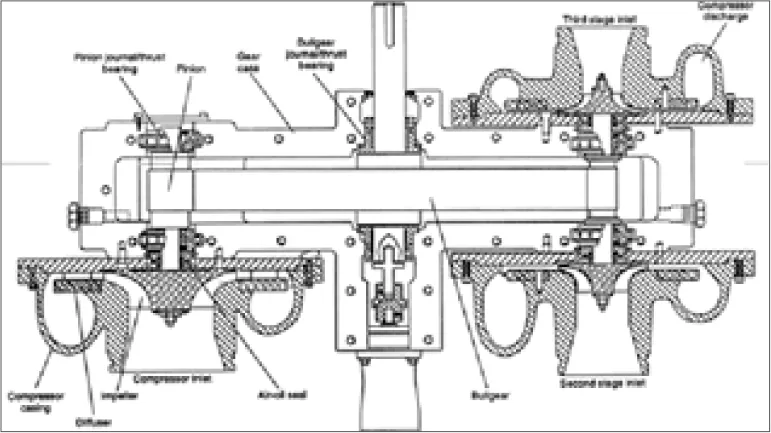
INTEGRALLY GEARED COMPRESSOR ARRANGEMENT
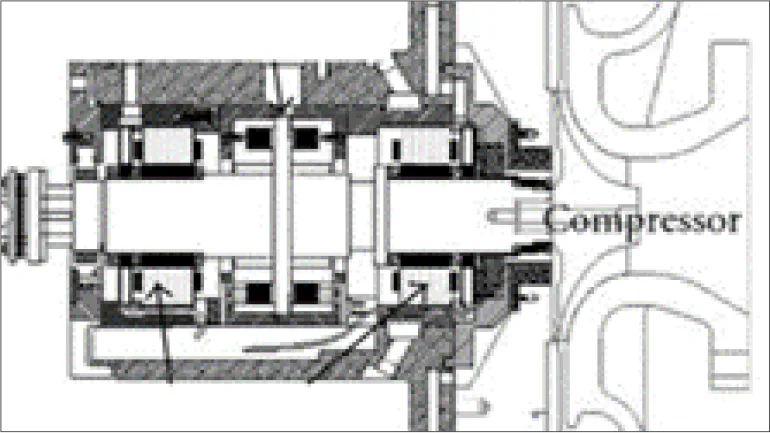
OVERHUNG IMPELLER COMPRESSOR
A limitation to the head may be the temperature limits of the compressor; typically, the discharge temperatures are limited to about 200° C.
If more head is required, the gas must be cooled during the compression process.
•up to three compressor casings (Between-Bearings type) can be coupled with the same driver (having one or two driving shaft ends), with one or more gearboxes, if necessary
•integrally geared compressor type with multiple pinions, usually one section for each stage
•rarely, also hybrid solution of the above mentioned casesSEALS
Seals are used to keep the gas from escaping through the bearings: so, both shaft ends are to be sealed for Between-Bearing compressors and each shaft end close to an overhung impeller. Except for applications in air or nitrogen compression, where often carbon ring seals or labyrinth seals are used, nowadays all centrifugal compressors use dry gas seals (DGS).
For dry gas seals, the sealing is accomplished by a stationary and a rotating disk, with a very small gap (about 5µm) between them. At standstill, springs press the movable seal disk onto the stationary disk. Once the compressor shaft starts to rotate, the groove pattern on one of the disks causes a separating force, making the seals run without mechanical contact of sealing surfaces. Four different arrangements are possible for DGS: single, double, tandem, tandem with intermediate labyrinth; the last one being applied in the most of applications.
At present, high speed compressor rotors (both “Integrally Geared” and not) are generally equipped with tilting pad bearings (2 Journal and 1 Thrust), since they are the most suitable for stability reasons (capability to resist any unbalancing action of the oil film), while low speed compressor shafts (for instance: bull gear shaft of “Integrally Geared” compressors) are equipped with fixed geometry bearings (for instance, 2 Journal plain type and 1 Thrust tapered land type).